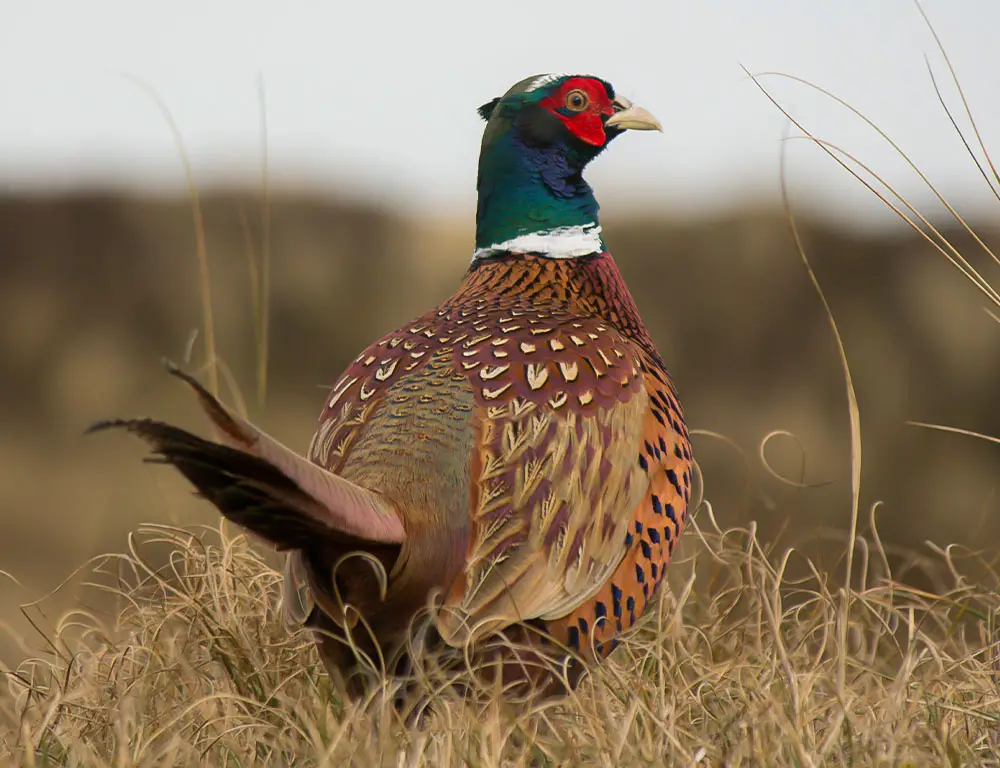Phasianidae, a diverse family of birds encompassing pheasants, partridges, quails, and more, captivates with its wide-ranging species and unique characteristics.
With over 200 species found across diverse habitats worldwide, Phasianidae birds are renowned for their colorful plumage, distinctive calls, and cultural significance.
From the majestic pheasants adorning forests to the bustling quails traversing grasslands, Phasianidae showcases the rich diversity of avian life.
This family’s ground-nesting habits, seasonal behaviors, and status as game birds add to its intrigue, drawing the attention of bird enthusiasts and researchers alike.
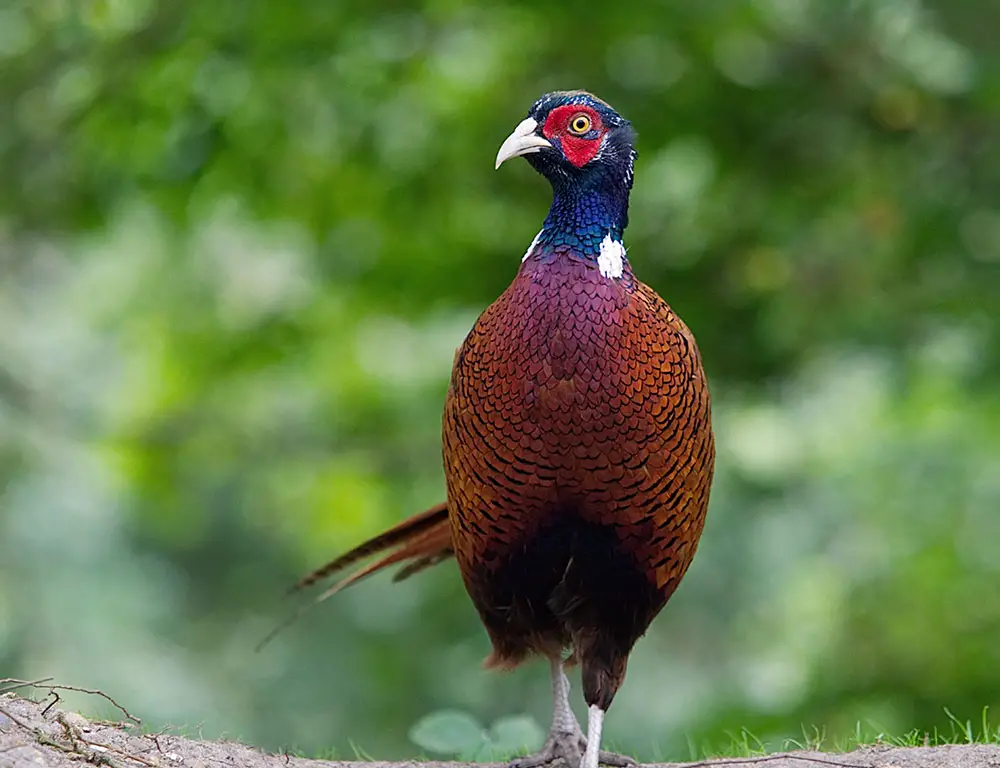
Some Interesting Characteristics Of Phasianidae
Phasianidae is a large and diverse family of birds, which includes pheasants, partridges, quails, chickens, turkeys, peafowl, and grouse. Here are some of the common characteristics of this fascinating and beautiful family of birds
Physical Characteristics Of Phasianidae
Phasianidae is a large and diverse family of birds, which includes pheasants, partridges, quails, chickens, turkeys, peafowl, and grouse.
They are primarily found in Asia, Europe, and Africa, where they inhabit various habitats such as forests, grasslands, deserts, and mountains.
They are also domesticated and introduced to other parts of the world as game birds, pets, or ornamental birds. Here are some of the physical characteristics of this fascinating and beautiful family of birds:
Size And Shape
Phasianidae is a family of medium to large birds ranging from 12 cm to 2 m in length and from 40 g to 20 kg in weight. They have a stout body, a small head, a short bill, and strong legs.
The tail is usually long and pointed and may have different shapes and patterns depending on the species. The wings are short and rounded, and the feet are generally four-toed, with the hind toe raised or absent.
Color And Pattern
Phasianidae is a family of colorful and diverse birds with variousplumage colors and patterns depending on species, sex, age, and season.
The males are usually more colorful and conspicuous than the females and may have iridescent, metallic, or glossy feathers. The females are generally duller, more cryptic, and may have mottled, barred, or striped feathers.
The juveniles are similar to the females but smaller and less developed. The plumage may also change with the seasons, and some species may have different color morphs or forms.
Sexual Dimorphism
Phasianidae is a family of sexually dimorphic birds, meaning the male and female have different appearances. As described above, the male and female differ in size, color, pattern, and ornamentation.
The male is usually larger and heavier than the female and has a longer and thicker bill, legs, and tail. The male also has more elaborate and distinctive features, such as crests, wattles, spurs, horns, or tails, which attract mates and display dominance.
The female is smaller and lighter than the male and has a shorter, thinner bill, legs, and tail. The female also lacks the ornamental features of the male and has a more camouflaged plumage, which helps her blend in with the environment and protect the eggs and chicks.
Moult
Phasianidae is a family of birds that undergo a partial or complete moult once or twice a year, usually after the breeding season and before the winter. During this time, the bird may lose some or all of its feathers and grow new ones.
The molt lasts about a month or two, and the bird regains its fresh and glossy plumage. The moult may also affect the color and pattern of the plumage, and some species may have different plumages for different seasons or occasions.
Voice
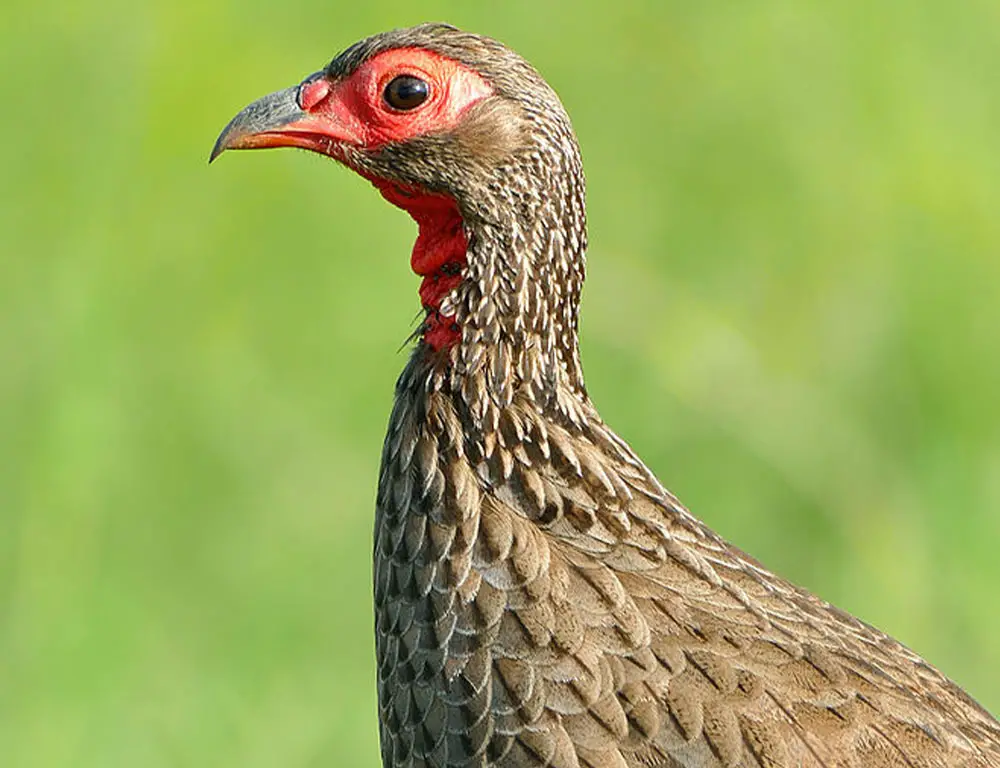
Phasianidae is a family of vocal and noisy birds that produce various sounds, such as crows, clucks, whistles, chirps, and calls.
The male is usually more vocal and louder than the female and may have a distinctive and complex song used to attract mates, defend territories, and communicate with other birds.
The female may also produce sounds, but they are softer and more straightforward and may be used to alarm, contact, or coordinate with the male or the chicks.
The chicks may also produce sounds but are usually faint and high-pitched and may be used to beg, follow, or alert the parents.
Diet And Nutrition
Phasianidae is a family of omnivorous and opportunistic birds which feed on various plant and animal matter. They mainly eat seeds, grains, fruits, berries, nuts, and buds of grasses, herbs, shrubs, and trees.
They also eat insects, worms, spiders, snails, mollusks, crustaceans, and small vertebrates such as lizards, frogs, mice, and birds. The bird forages on the ground or in the trees, often in flocks or pairs.
It may also visit feeders or human settlements to find food. It needs to drink water regularly and may visit ponds, streams, or puddles to quench its thirst.
Reproduction
Phasianidae is a family of monogamous or polygamous birds which breed once or twice a year, depending on the species and the region. The pair of the group forms a bond and defends a territory.
The nest is a shallow scrape or a depression on the ground, usually hidden by vegetation or rocks. The nest is lined with grass, feathers, and down. The female lays 2 to 20 eggs, which are white, cream, or brown and may have spots or markings.
The incubation period is about 18 to 30 days, and the chicks are precocial, which means they can walk and feed themselves soon after hatching. The parents guide and protect the chicks and teach them to fly and forage.
The fledging period is about 10 to 15 weeks, and the young may stay with their parents for some time before dispersing.
Distribution And Habitat
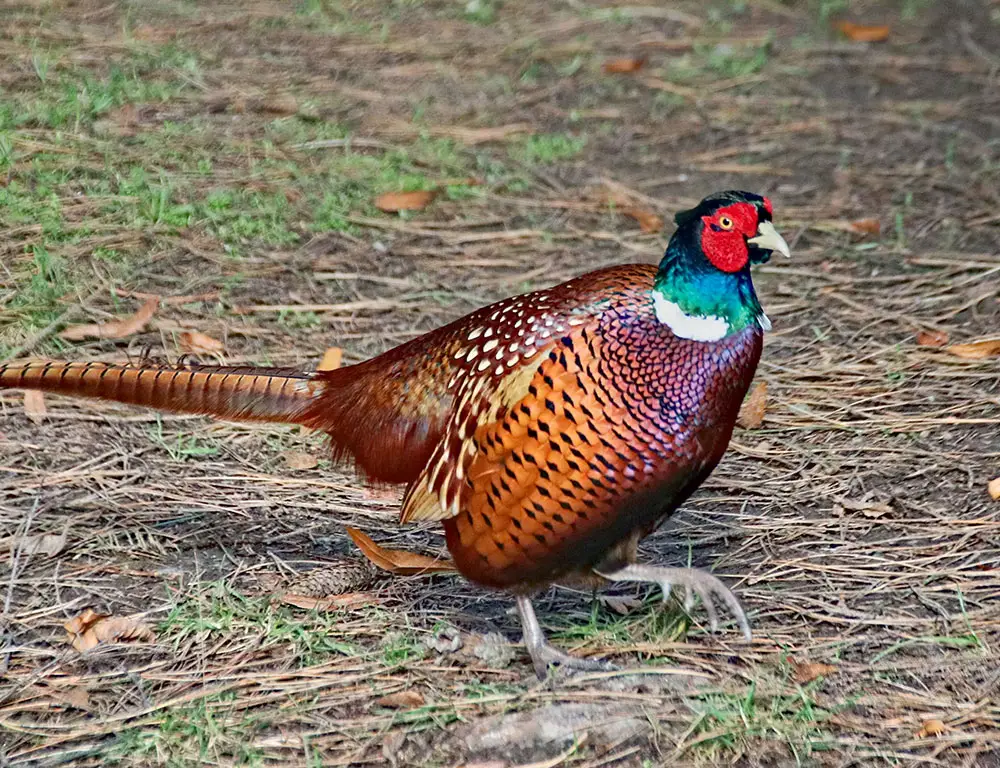
Phasianidae is a bird family with a wide and varied distribution, covering most of Asia, Europe, and Africa, and some parts of Oceania and the Americas.
They occupy various habitats, from tropical and temperate forests to arid and semi-arid grasslands, deserts, and mountains. They prefer dense vegetation, water sources, and food availability and avoid open or disturbed areas.
They can adapt to different climatic and environmental conditions, and some species can migrate or disperse to find suitable resources.
Behavior And Ecology
Phasianidae is a family of birds with complex and varied behavior and ecology, which depends on the species, sex, age, and season. They are primarily diurnal and active during the day, but some species may be crepuscular or nocturnal.
They have adaptations that help them survive, such as camouflage, spurs, glands, and dust baths.
Relationship With Humans
Phasianidae is a family of birds with a long and close relationship with humans, which can be positive or negative. Humans value and exploit them for various purposes, such as food, sport, pets, or ornaments.
Humans hunt, trap, and domesticate them for their meat, eggs, feathers, and companionship. They are also introduced and established by humans in many parts of the world as game birds, pets, or ornamental birds.
Humans also threaten and endanger them due to habitat loss, degradation, fragmentation, agriculture, urbanization, deforestation, and infrastructure development.
Systematics And Evolution
Phasianidae is a family of birds with rich and complex systematics and evolution, reflecting their diversity and adaptation. They are classified into several subfamilies, genera, and species based on their morphology, genetics, behavior, and ecology.
They are also related to other families of birds, such as Numididae, Megapodiidae, and Cracidae, which share a common ancestor with them. They evolved from a primitive galliform ancestor who lived about 40 million years ago.
They have diversified and adapted to different habitats and conditions and have developed various features and traits, such as color, pattern, ornamentation, and vocalization.
They have also hybridized and interbred with other species, creating new forms and variations.
Taxonomy
Here’s a simplified table of the taxonomy of the Phasianidae family:
| Taxonomic Level | Classification |
| Kingdom | Animalia |
| Phylum | Chordata |
| Class | Aves |
| Order | Galliformes |
| Family | Phasianidae |
The family Phasianidae belongs to the animal kingdom (Animalia), the chordate phylum (Chordata), the class of birds (Aves), and the order of Galliformes, which includes game birds such as pheasants, partridges, grouse, turkeys, and quails.
Nesting Habit of Oriental Phasianidae
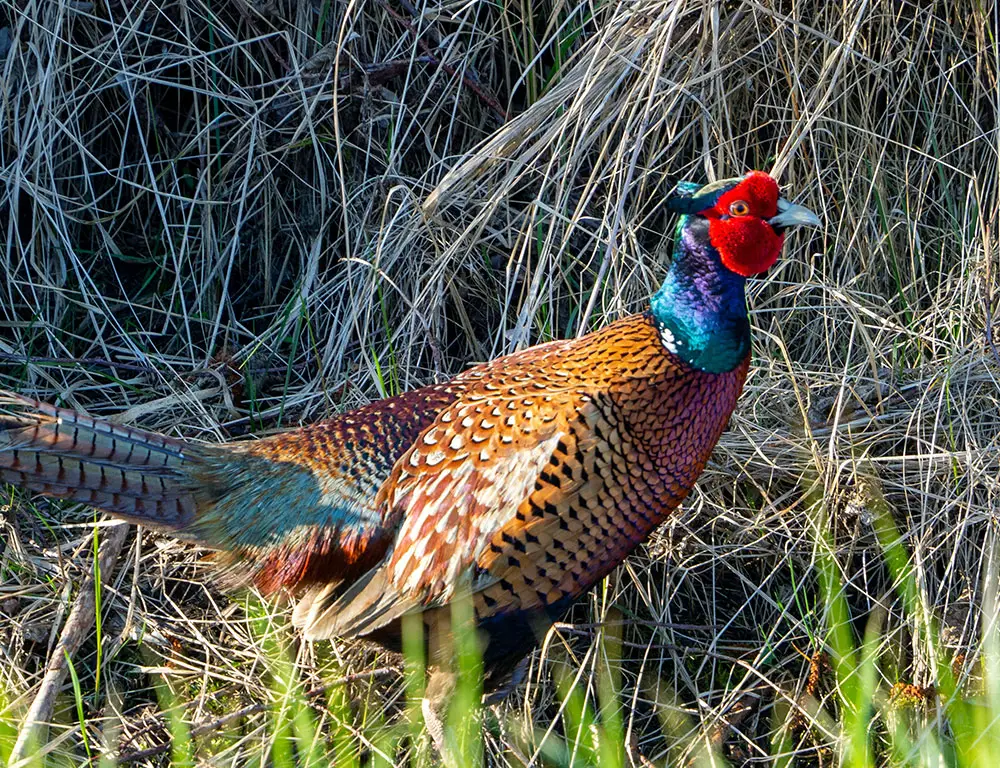
Here’s a simplified table outlining the nesting habits of Oriental Phasianidae:
| Nesting Habit | Description |
| Nest Type | Grasses, twigs, leaves, and other plant materials forming a simple nest structure |
| Nest Material | Found in various habitats, including grasslands, shrublands, forests, and agricultural areas |
| Nest Location | Grasses, twigs, leaves, and other plant materials form a simple nest structure |
| Nest Construction | Timing varies depending on species and geographic location, often coinciding with the breeding season. |
| Nesting Season | Usually consists of several eggs, with clutch size varying among species and individuals. |
| Clutch Size | Eggs are primarily incubated by the female bird, with both parents sometimes sharing incubation duties. |
| Incubation | They are typically built by the female bird, with the male sometimes assisting in gathering materials. |
| Fledging Period | Chicks fledge after incubation, typically ranging from a few weeks to a month. |
| Nesting Success | Success rates can vary depending on predation, habitat quality, and environmental conditions. |
This table provides insights into the nesting behaviors and characteristics of Oriental Phasianidae, highlighting their adaptations to diverse habitats and their reproductive ecology.
Ranging Map Of Phasianidae

Phasianidae Is A Diverse Family Of Birds comprising various species of pheasants, partridges, quails, and relatives. While creating a specific ranging map for Phasianidae is challenging due to the vast number of species within the family, we can discuss the general distribution patterns.
Eurasia
Many species of Phasianidae are found across Eurasia, spanning from Europe to Asia. This includes the common pheasant (Phasianus colchicus) and various partridge species.
North America
Some species, such as the ruffed grouse (Bonasa umbellus) and the wild turkey (Meleagris gallopavo), are native to North America.
Africa
Certain Phasianidae species, like the helmeted guineafowl (Numida meleagris), are indigenous to Africa.
South Asia
India, Nepal, and surrounding regions are home to several pheasant and partridge species, including the Indian peafowl (Pavo cristatus) and the grey francolin (Francolinus pondicerianus).
Southeast Asia
Countries like Thailand, Vietnam, and Malaysia host various Phasianidae species, including quails and pheasants.
While Phasianidae species exhibit diverse distribution patterns, habitat availability, climate, and human activities often influence their ranges.
Conservation efforts aim to protect these birds and their habitats, ensuring their continued presence in ecosystems worldwide.
What Are Some Common Diseases And Their Treatment Of A Phasianidae?
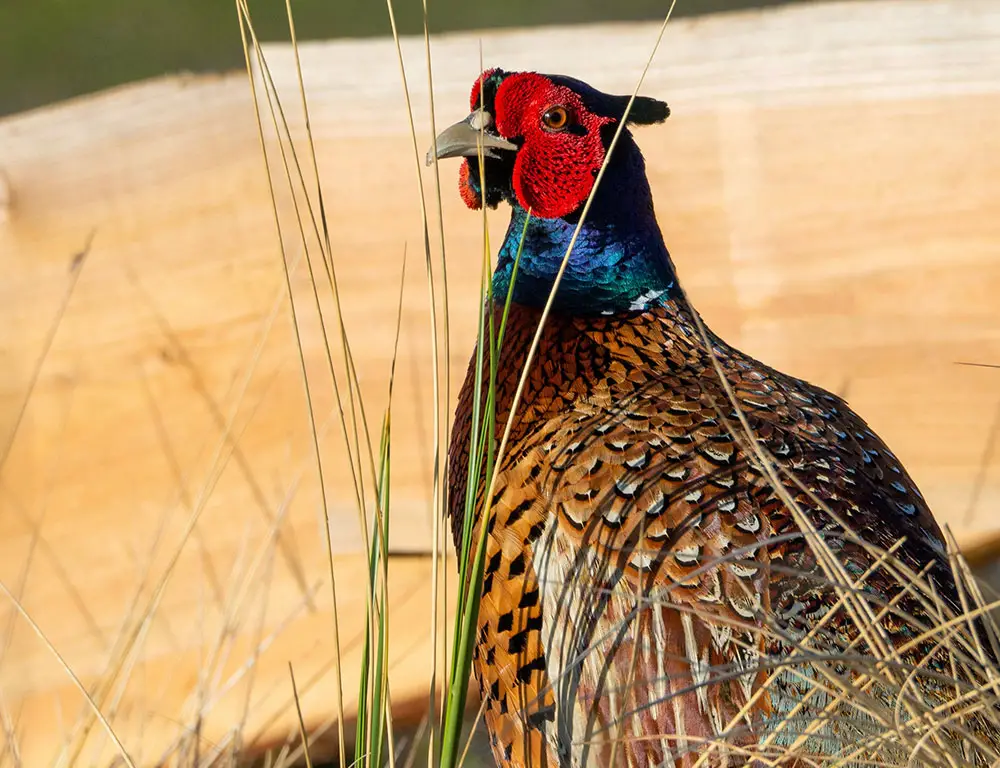
Phasianidae, encompassing pheasants, partridges, quails, and more, are susceptible to various diseases affecting their health and well-being. Proper diagnosis and treatment are essential to maintain their captivity and the wild populations.
Avian Influenza (Bird Flu)
Avian influenza is a viral disease affecting Phasianidae, causing symptoms like respiratory distress, lethargy, and sudden death. Treatment involves supportive care, including antiviral medications and isolation to prevent spread.
Coccidiosis
Coccidiosis is a common protozoan infection in Phasianidae, leading to diarrhea, weight loss, and dehydration. Treatment includes oral or injectable medications such as sulfa drugs or amprolium to control the parasite’s growth.
Newcastle Disease
Newcastle disease is a viral infection that affects Phasianidae’s respiratory, nervous, and digestive systems, leading to severe illness and death. Treatment involves supportive care, including fluid therapy and antibiotics to prevent secondary infections.
Fowl Cholera
Fowl cholera is a bacterial infection caused by Pasteurella multocida, resulting in respiratory symptoms, swollen joints, and sudden death in Phasianidae. Treatment typically involves antibiotic therapy, such as tetracyclines or sulfonamides, and supportive care.
Egg Binding
Egg binding occurs when a female Phasianidae cannot lay an egg, leading to abdominal swelling, lethargy, and difficulty breathing. Treatment involves gentle massage to help expel the egg and supplemental calcium and warm baths to relax muscles.
Aspergillosis
Aspergillosis is a fungal infection common in Phasianidae, particularly in poorly ventilated or damp environments. Symptoms include respiratory distress and weakness.
Treatment includes antifungal medications such as itraconazole or voriconazole and improving husbandry conditions.
Blackhead Disease
Blackhead disease, caused by the protozoan parasite Histomonas meleagridis, can affect Phasianidae, causing liver damage, diarrhea, and death. Treatment involves deworming medications such as fenbendazole or metronidazole and supportive care to manage symptoms.
Regular veterinary check-ups, proper sanitation, and biosecurity measures are essential for preventing and managing diseases in Phasianidae populations, ensuring their health and longevity in captivity and the wild.
Conclusion
Phasianidae is a fascinating testament to the diversity and adaptability of avian life. From their vibrant plumage to their cultural significance, these birds enrich ecosystems and human societies.
They are primarily found in Asia, Europe, and Africa, where they inhabit various habitats such as forests, grasslands, deserts, and mountains. They are also domesticated and introduced to other parts of the world as game birds, pets, or ornamental birds.
As stewards of the natural world, we must continue to appreciate and conserve Phasianidae species and their habitats.
By protecting their diverse habitats and addressing threats such as habitat loss and hunting pressure, we can ensure Phasianidae’s continued survival and appreciation for generations to come.
